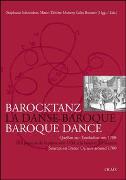- Start
- Barocktanz im Zeichen französisch-deutschen Kulturtransfers / La danse baroque et les transferts culturels entre France et Allemagne / Baroque Dance and the Transfer of Culture between France and Germany
Barocktanz im Zeichen französisch-deutschen Kulturtransfers / La danse baroque et les transferts culturels entre France et Allemagne / Baroque Dance and the Transfer of Culture between France and Germany
Angebote / Angebote:
Es gehört zu den glücklichen Umständen der Tanzhistoriographie, dass der "Barocktanz" - die höfisch geprägte Tanzkunst des 17. und frühen 18. Jahrhunderts - besonders reichhaltig dokumentiert ist. Von großem Interesse ist hierbei die Entwicklung einer Tanznotation als kunstvolles Medium der Verschriftlichung streng kodifizierter Bewegungsfolgen.
Während sich die Barocktanzforschung bislang vornehmlich auf Frankreich und England konzentrierte, geht diese Publikation der Aneignung französischer Tanzkultur im deutschsprachigen Raum nach. Im Zentrum stehen zwei Tanzbücher, die im gleichen Jahr (1705) in benachbarten Orten (Braunschweig/Wolfenbüttel bzw. Leipzig/Glückstadt) erschienen: Huguo Bonnefonds "Abregée des Principes de la Dance" und der mit dem Autorenkürzel IHP versehene "Maître de Danse oder Tantz=Meister". Sie werden im Original abgebildet, für den praktischen Gebrauch transkribiert und dreisprachig kommentiert, um zu Rekonstruktion und Neuinterpretation anzuregen.
L'historiographie de la danse a la grande chance de disposer, pour la « danse baroque » (l'art de la belle danse aristocratique, pratiquée à la fin du XVIIe et au début du XVIIIe siècle), d'une documentation particulièrement abondante. L'un des aspects les plus intéressants en est l'élaboration d'un système de notation de la danse, conçu comme représentation graphique ingénieuse de mouvements
rigoureusement codifiés.
Tandis que la recherche en danse baroque s'est jusqu'alors surtout concentrée sur la France et l'Angleterre, la présente publication étudie la manière dont la pratique de la danse française fut adoptée dans l'aire germanophone. Au centre de l'étude, on trouve deux manuels de danse, parus la même année (1705) dans des régions proches (Brunswick/Wolfenbüttel et Leipzig/ Glückstadt): "l'Abregée des Principes de la Dance" de Hugues Bonnefond, et le "Maître de Danse oder Tantz=Meister" d'un auteur identifié par ses seules initiales, I.H.P. Ces sources sont reproduites à l'identique, puis transposées pour un usage pratique etpourvues d'un commentaire en trois langues, afin de permettre la reconstruction et de nouvelles interprétations.
One of the most fortunate facts in the historiography of dance is that "baroque dance" - the court-influenced dance of the 17th and early 18th centuries - is particularly well documented. One major area of interest is the development of dance notation as an artistic medium for the graphic representation of strictly codified movements.
While previous research into baroque dance has concentrated principally on France and England, this book investigates the adoption of French dance culture in the German-speaking world. Central to the study are two dance books which appeared in the same year (1705) in neighbouring areas (one in Branschweig and Wolfenbüttel, one in Leipzig and Glückstadt): Hugo Bonnefond's "Abregée des Principes de la Dance" and the "Maître de Danse oder Tantz=Meister", whose author is identified only by the initials IHP. To stimulate reconstruction and reinterpretation the sources are reproduced in their original form, transcribed for practical use and provided with a trilingual commentary.
Lieferbar in ca. 5-10 Arbeitstagen
